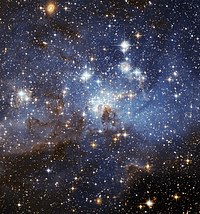
Photo from wikipedia
Multi-epoch observations have revealed the variability of pre-main sequence stars and/or their environment. Moreover, structures in orbital motion around the central star, resulting from planet-disk interaction, are predicted to cause… Click to show full abstract
Multi-epoch observations have revealed the variability of pre-main sequence stars and/or their environment. Moreover, structures in orbital motion around the central star, resulting from planet-disk interaction, are predicted to cause temporal variations in the brightness distributions of protoplanetary disks. Through repeated observations with the Very Large Telescope Interferometer (VLTI) over nearly two decades, the ESO Archive has become a treasure chest containing high-resolution multi-epoch near- and mid-infrared observations of the potential planet-forming regions in protoplanetary disks. We aim to investigate whether the existing multi-epoch observations provide evidence for the variability of the brightness distributions of the innermost few astronomical units of protoplanetary disks and to quantify any variations detected. We present different approaches to search for evidence of temporal variations based on multi-epoch observations obtained with the VLTI instruments PIONIER, AMBER, and MIDI for 68 pre-main sequence stars. For nine objects in our sample, multi-epoch data obtained using equal baselines are available that allow us to directly detect variations in the visibilities due to temporally variable brightness distributions. Significant variations of the near-infrared visibilities obtained in different epochs with PIONIER and/or AMBER for HD 50138, DX Cha, HD 142527, V856 Sco, HD 163296, and R CrA were found. By estimating the impact of a small variation of the baseline on the measured squared visibilities, we are able to compare the data of another 12 pre-main sequence stars. Thereby, we find evidence for temporal variations of the brightness distribution of one additional object, AK Sco. Besides the two binaries DX Cha and AK Sco, HD 50138 and V856 Sco also show signs of variability caused by variations of asymmetric structures in the brightness distribution.
Journal Title: Astronomy and Astrophysics
Year Published: 2020
Link to full text (if available)
Share on Social Media: Sign Up to like & get
recommendations!